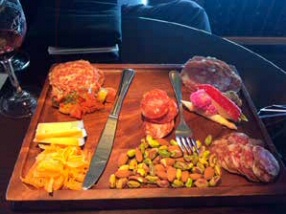|

Charcuterie [shahr-koo-tuh-ree] is a French word which describes a store where meat products are sold. These delectable products come in the form of sausages, hams, rillettes, patés, bacons, confits, head cheeses, terrines…basically all those fatty, salty pork products we’re told are not the most healthy for us. Despite this fact, many of us find these foods irresistible. Charcuterie is also a generalized term for all of these products, which traditionally are pork-based, but that’s more of a guideline than a rule. We’ve carried over this fancy word into our English vocabulary and it’s often associated with all things wine-related. (We know you’ll probably find this is shocking since we have it as the subject of one of our newsletter articles.)
The trendy approach to the topic of charcuterie and wine is to suggest going against tradition. And while I’m going to present that side as well and hold nothing against it, I’m going to be upfront and honest and suggest I see no reason to veer away from tradition on this one, unless it is in the name of pure epicurious curiosity. There’s nothing better to me than pairing a smoky, hearty full-bodied red wine with an assortment of dry cured meats and sausages. But I’m getting ahead of myself. Let’s start from the beginning with some definitions.
Dry curing involves salting meat and keeping it in a cool room for a long time, a very long time. Obviously, there’s more to it than that and there can be wide variations, but the basic premise remains.
Dry Cured Ham
While we make good cured ham here in the States, such as dry cured Virginia ham, the old country still dominates in high quality cured ham production. France’s gem, among many, may be Jambon de Bayonne. I could admittedly be biased with my love of all things Basque, but this traditional ham is simply outstanding. A similar, more well-known ham from Italy is prosciutto. Spain has serrano and Germany’s black forest ham falls into this category.
Dry Cured Sausage
Dry cured sausages are hard, dry sausages which do not need to be refrigerated. Again, sure we do it okay, but Europe has us beat in this department. France has its saucisson, Italy has salami and soppressata, Spain has chorizo, and Germany has landjäger.
Cooked Sausage
Cooked sausage is the one area where we’re pretty much on an equal standing with Europe. Although France’s saucisson à l’ail (garlic sausage), boudin (blood sausage), and Italy’s mortadella remain worldwide favorites. And we can’t leave out Germany’s frankfurter…the original hot dog. However, I think a good Cajun andouille will match up with anything out there.
Now let’s get to the ...Wine
As already admitted, I personally am a traditionalist when it comes to pairing charcuterie with wine. I’m going to pull the cork out of a meaty bottle to match with my array of cured and smoked meats. I’m going to reach for a full-bodied Syrah or Rhône-style wine, or maybe even a Tempranillo, every time. These are rustic, hearty, meaty foods we’re talking about. For many people, matching with equally rustic, hearty red wines is the way to go. Although don’t just open any bottle of red wine. Often Pinot Noir is going to be too delicate and will be overpowered by charcuterie. And stay away from overly fruit-forward reds, such as Merlots, if possible. You also want to avoid going too BIG in your red wine selection. Big Zinfandels, Petite Sirahs, even some Cabernet Sauvignons or Cab-based blends will simply overpower your palate and you may as well be eating sliced ham from the grocery store.
Now on to that other theory. - Some people would cross a big “X” through the paragraph above and say that the time-honored tradition of hearty reds with charcuterie is so last century. Proponents of this other approach would say that full-bodied reds are the last thing you should open, and that instead you should try light-bodied reds, even chilled reds, including cool climate Pinot Noirs (such as Monterey County Pinot Noirs). This group also normally likes to suggest chilled rosés and off-dry Rieslings. And there are even some among them that recommend sparkling wines, especially sparking reds wines (which do exist, but are somewhat rare.) The general idea here is that these wines will have lower tannin and alcohol levels which will better complement your salty charcuterie selections more evenly.
Again, it’s not for me, but I absolutely recommend experimenting with wine pairing. After all, each of us has our own unique palate and may find a particular pairing amazing, even if no one else agrees.
And here at A Taste of Monterey we’ve got you covered. We offer a variety of charcuterie options which you can try pairing with our outstanding wines. You’ll receive your charcuterie plate beautifully presented and our knowledgeable staff will be able to thoroughly describe each selection to you. So come on in and see for yourself what kind of wine you prefer with charcuterie. Clearly there are a lot of different possibilities and even European charcuterie is fairly easy to find these days. And you always know where to find the wine! |